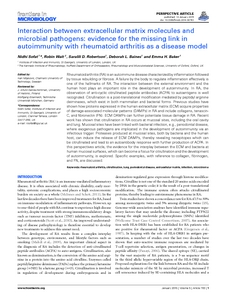Sofat, N; Wait, R; Robertson, SD; Baines, DL; Baker, EH
(2014)
Interaction between extracellular matrix molecules and microbial pathogens: evidence for the missing link in autoimmunity with rheumatoid arthritis as a disease model.
Frontiers in Microbiology, 5 (783).
ISSN 1664-302X
https://doi.org/10.3389/fmicb.2014.00783
SGUL Authors: Baines, Deborah Baker, Emma Harriet Sofat, Nidhi
![[img]](https://openaccess.sgul.ac.uk/107334/1.hassmallThumbnailVersion/Interaction_between_extracellular_matrix_molecules_microbial_pathogens.pdf)  Preview |
|
["document_typename_application/pdf; charset=binary" not defined]
Published Version
Download (1MB)
| Preview
|
Abstract
Rheumatoid arthritis (RA) is an autoimmune disease characterized by inflammation followed by tissue rebuilding or fibrosis. A failure by the body to regulate inflammation effectively is one of the hallmarks of RA. The interaction between the external environment and the human host plays an important role in the development of autoimmunity. In RA, the observation of anti-cyclic citrullinated peptide antibodies (ACPA) to autoantigens is well recognized. Citrullination is a post-translational modification mediated by peptidyl arginine deiminases, which exist in both mammalian and bacterial forms. Previous studies have shown how proteins expressed in the human extracellular matrix (ECM) acquire properties of damage-associated molecular patterns (DAMPs) in RA and include collagens, tenascin-C, and fibronectin (FN). ECM DAMPs can further potentiate tissue damage in RA. Recent work has shown that citrullination in RA occurs at mucosal sites, including the oral cavity and lung. Mucosal sites have been linked with bacterial infection, e.g., periodontal disease, where exogenous pathogens are implicated in the development of autoimmunity via an infectious trigger. Proteases produced at mucosal sites, both by bacteria and the human host, can induce the release of ECM DAMPs, thereby revealing neoepitopes which can be citrullinated and lead to an autoantibody response with further production of ACPA. In this perspectives article, the evidence for the interplay between the ECM and bacteria at human mucosal surfaces, which can become a focus for citrullination and the development of autoimmunity, is explored. Specific examples, with reference to collagen, fibrinogen, and FN, are discussed.
| Item Type: |
Article
|
| Additional Information: |
© 2015 Sofat, Wait, Robertson, Baines and Baker. This is an open-access article distributed under the terms of the Creative Commons Attribution License (CC BY). The use, distribution or reproduction in other forums is permitted, provided the original author(s) or licensor are credited and that the original publication in this journal is cited, in accordance with accepted academic practice. No use, distribution or reproduction is permitted which does not comply with these terms. |
| Keywords: |
citrullination, extracellular matrix, infection, lung, microbiome, periodontal disease, rheumatoid arthritis |
| SGUL Research Institute / Research Centre: |
Academic Structure > Infection and Immunity Research Institute (INII) |
| Journal or Publication Title: |
Frontiers in Microbiology |
| ISSN: |
1664-302X |
| Language: |
eng |
| Dates: |
| Date | Event |
|---|
| 14 January 2014 | Published |
|
| Projects: |
|
| PubMed ID: |
25642219 |
 |
Go to PubMed abstract |
| URI: |
https://openaccess.sgul.ac.uk/id/eprint/107334 |
| Publisher's version: |
https://doi.org/10.3389/fmicb.2014.00783 |
Statistics
Item downloaded times since 26 Feb 2015.
Actions (login required)
 |
Edit Item |



